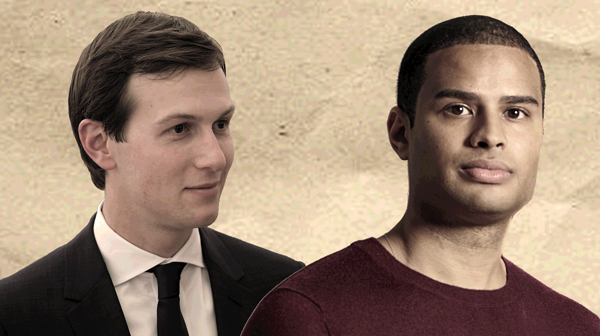Most Americans know Cadre as Jared Kushner’s [TRDataCustom] startup, the investment he infamously failed to mention on his White House ethics disclosure form. But the political hullabaloo makes it easy to overlook that its actual business model is also a big deal.
Last week, the online real estate investment platform raised $65 million in a round led by Andreessen Horowitz, reportedly at a $800 million valuation. Part of Cadre’s appeal, according to sources familiar with the firm, is its vision of an online trading platform for real estate equity stakes, a sort of parallel stock market. It sounds dry, but it could be a game changer for the industry — if it works.
Similar to other crowdfunding startups, Cadre offers investors the chance to buy a small stake in a commercial property. The company invests in real estate deals using a credit line and then makes them available to members of its online platform, who can buy small-ish stakes in the property. The premise is simple: savers can invest in buildings they otherwise couldn’t afford (or, for wealthier investors, don’t want to bet too heavily on) without the stock-market risk of buying REIT shares or the paperwork and brokerage fees of more traditional syndication.
But there’s a problem. What if an investor changes their mind or suddenly needs cash? REIT investors can sell their shares, homeowners can list their homes. Crowdfunding offers no such easy exit, which is why several platforms focus on short-term debt or preferred equity deals that pay out after a year or two.
Here’s where Cadre’s secondary market comes in. According to sources, the company is working on an online platform for investors to trade their property stakes. The idea is that anyone who invested in a property through Cadre and wants to sell can list the note and find another Cadre member to buy it. Think of it as a members-only Craigslist for property trades.
If the platform were to truly take off, it could become a parallel, private real estate stock market and liquify an illiquid asset class. But it faces some challenges, as the example of SecondMarket shows.
Founded in 2004, SecondMarket acts as a marketplace for private company shares. The firm raised $34 million from investors, according to Crunchbase. It appealed to tech entrepreneurs and VC types who wanted to turn their companies’ valuations into cash but didn’t want the hassle of an IPO. Facebook was reportedly one of the firms that sold shares in secondary markets.
But the concept never quite took off as hoped. A 2014 report in Fortune claimed that the “pendulum has since swung in the other direction” in part because startups balked at having strangers as shareholders and discouraged their employees from selling stakes prior to an IPO. A year earlier, SecondMarket had shifted its business model to company-sponsored offerings.
SecondMarket, which NASDAQ acquired in 2015, only had one real competitor: the IPO. Cadre has to compete with plenty of other funding sources, from private equity firms over insurers to pension funds. That creates a problem. Developers with good standing can generally get cheap funding elsewhere and don’t need to bring in Cadre as a private-equity-partner substitute. Those who turn to unproven startups like Cadre are more likely to offer less appealing deals that couldn’t get funding elsewhere, according to Bessemer Venture Partners’ Jeremy Levine.
“There’s a horrible natural selection problem,” Levine said at the VTS Accelerator conference last week, adding that he thinks Cadre’s model is “highly unlikely” to work.
Cadre appears to be trying to solve that problem by using the Kushner connection to get access to deals. For example, it funded Kushner’s acquisition of an Astoria multifamily portfolio in January 2015, according to a press release. Kushner sold the buildings earlier this year. In a release, Cadre described the sale as “the first realization on Cadre’s platform,” with CEO Ryan Williams saying it “demonstrates the quality and promise of the transformational platform we’ve built.”
But Cadre can’t rely on the the family of its co-founder indefinitely, nor on the assets of its bigwig backers such as Michael Fascitelli.
The more serious challenge facing Cadre is a dilemma shared with most other growing marketplaces. The platform only makes sense if a lot of people are using it and people know they can find someone to buy their note – the more users Craiglist has, the more appealing its platform. But how do you go from small to big if the small marketplace isn’t really that appealing?
One real estate finance source, speaking on condition of anonymity, argued that “it would have to get to billions of the same security traded until there could be a real secondary market.” Standardization is another issue. Every real estate deal is different, which makes it hard for investors to price them properly online. The source suggested this means notes could sell for an average discount of 20 to 30 percent online.
“I think talk of a secondary market in real estate is premature,” he said.
People have tried to create secondary markets for private real estate before, but previous attempts centered on derivatives, meaning investors wouldn’t actually be trading real estate stakes but synthetic securities tied to the performance of real estate. Howard Lutnick announced one such attempt in 2012, although it apparently didn’t come to fruition. In March financial services firm Global Index Group launched a new attempt.
But just because Cadre’s secondary market faces tall hurdles doesn’t mean it’s not worth a try. If it works, it could open commercial real estate to a new group of investors, which should benefit the industry as a whole. “Significant value can be created as these real estate investments become liquid which could contribute to a lower cost of capital,” said Paul Deitch, CEO of crowdfunding company Patch of Land and a former banker. “Today, there is a return premium expectation on real estate because of its inherent lack of liquidity.” It could also create a handy real-time tracker of property valuations, since Cadre members can see what buildings are trading for at any moment.
Perhaps the best way to overcome the chicken and egg dilemma is to sell this vision to potential customers and get them to sign on for the greater good. Cadre’s Williams, who declined to comment for this column, appears to be already be doing that. “On average — I actually counted — I have 18 to 19 meetings a day, pretty much back to back,” he told The Real Deal in February. He will have to keep up that pace for a while if he wants Cadre’s marketplace to succeed.




